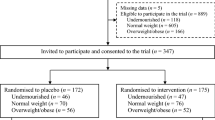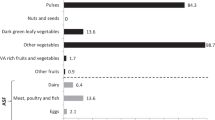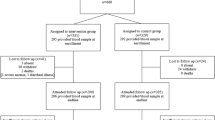Abstract
BACKGROUND/OBJECTIVES:
In the absence of biochemical data on iron status in preschoolers, data on the adequacy of iron intake may be used to assess the possible risk of iron deficiency in this population group. Therefore, this study aims to investigate iron intake and its food sources in Flemish preschoolers.
SUBJECTS/METHODS:
A total of 661 Flemish preschoolers 2.5–6.5 years old were recruited via a random cluster sampling design, using schools as primary sampling units. Three-day estimated diet records were used to assess dietary intakes. The contribution to iron intake (haem and non-haem) of 57 food groups was computed by summing the amount provided by the food group for all individuals divided by the total intake for all individuals.
RESULTS:
Mean total iron intake (s.d.) was 7.4 (±2.3) and 6.7 (±2.8) mg/day for boys and girls, respectively. In all 65% of the children <4 years old and 45% of those 4–6.5 years old presented adequate iron intakes. The food groups with the highest mean proportional contribution to total iron intake were bread, meat and meat products, breakfast cereals and sweet snacks (in that order). Children from small families whose mother had a low educational level had higher iron intakes.
CONCLUSION:
Iron intakes were similar for boys and girls and almost half of the Flemish preschoolers do not comply with the dietary iron recommendations.
This is a preview of subscription content, access via your institution
Access options
Subscribe to this journal
Receive 12 print issues and online access
$259.00 per year
only $21.58 per issue
Buy this article
- Purchase on Springer Link
- Instant access to full article PDF
Prices may be subject to local taxes which are calculated during checkout
Similar content being viewed by others
References
Hoge Gezondheidsraad . Dietary recommendations for Belgium: revised version November 2006 (Voedingsaanbevelingen voor België: herziene versie 2006), No. 7145-2. Brussel, 2006.
Centers for Disease Control and Prevention (CDC). Recommendations to prevent and control iron deficiency in the United States. MMWR Recomm Rep. Centers for Disease Control and Prevention, US Government Printing Office (GPO): Washington, DC, 1998; 47, 1–29.
FAO/WHO. Vitamin and mineral requirements in human nutrition. World Health Organization and Food and Agriculture Organization of the United Nations: Rome, 2004.
Pynaert I, Matthys C, Bellemans M, De Maeyer M, De Henauw S, De Backer G . Iron intake and dietary sources of iron in Flemish adolescents. Eur J Clin Nutr 2005; 59, 826–834.
Heath AL, Fairweather-Tait SJ . Clinical implications of changes in the modern diet: iron intake, absorption and status. Best Pract Res Clin Haematol 2002; 15, 225–241.
Huybrechts I, Matthys C, Pynaert I, De Maeyer M, Bellemans M, De Geeter H et al. Flanders preschool dietary survey: rationale, aims, design, methodology and population characteristics. Arch Public Health 2008; 66, 5–25.
Black AE, Goldberg GR, Jebb SA, Livingstone MB, Cole TJ, Prentice AM . Critical evaluation of energy intake data using fundamental principles of energy physiology: 2. Evaluating the results of published surveys. Eur J Clin Nutr 1991; 45, 583–599.
Huybrechts I, De Henauw S . Energy and nutrient intakes by pre-school children in Flanders-Belgium. Br J Nutr 2007; 98, 600–610.
NEVO. NEVO-Table, Dutch Food Composition Table 2001. NEVO Foundation (in Dutch): Zeist, 2001.
VIGeZ. De voedingsdriehoek: een praktische voedingsgids. Vlaams Instituut voor Gezondheidspromotie en Ziektepreventie (VIGeZ) 2008. Available from: http://www.vigez.be/uploads/documentenbank/6ef36d137f636f8f73577256ec756770.pdf.
Guenther PM, Kott PS, Carriquiry AL . Development of an approach for estimating usual nutrient intake distributions at the population level. J Nutr 1997; 127, 1106–1112.
Nusser SM, Carriquiry AL, Dodd KW, Fuller WA . A semiparametric transformation approach to estimating usual daily intake distributions. J Am Stat Assoc 1996; 91, 1440–1449.
Iowa State University. C-side. http://www.cssm.iastate.edu/software/cside.html 2006.
Hoge G . Dietary recommendations for Belgium: revised version November 2009 (Voedingsaanbevelingen voor België: herziene versie 2009), no. 8309. Brussel, 2009.
IOM, Food and Nutrition Board. Dietary Reference Intakes for Vitamin A, Vitamin K, Arsenic, Boron, Chromium, Copper, Iodine, Iron, Manganese, Molybdenum, Nickel, Silicon, Vanadium, and Zinc. National Academy Press: Washington, DC, 2001.
Carriquiry AL . Assessing the prevalence of nutrient inadequacy. Public Health Nutr 1999; 2, 23–33.
Gibson RS, Ferguson EL . An Interactive 24-hour Recall for Assessing the Adequacy of Iron and Zinc Intakes in Developing Countries, Report No. 8. International Food Policy Research Institute (IFPRI) and International Center for Tropical Agriculture (CIAT): Washington, DC and CA, 2008.
Fox MK, Reidy K, Novak T, Ziegler P . Sources of energy and nutrients in the diets of infants and toddlers. J Am Diet Assoc 2006; 106 (Suppl 1), S28–S42.
Krebs-Smith SM, Kott PS, Guenther PM . Mean proportion and population proportion: two answers to the same question? J Am Diet Assoc 1989; 89, 671–676.
Royo-Bordonada MA, Gorgojo L, de Oya M, Garces C, Rodriguez-Artalejo F, Rubio R et al. Food sources of nutrients in the diet of Spanish children: the Four Provinces Study. Br J Nutr 2003; 89, 105–114.
Lambert J, Agostoni C, Elmadfa I, Hulshof K, Krause E, Livingstone B et al. Dietary intake and nutritional status of children and adolescents in Europe. Br J Nutr 2004; 92 (Suppl 2), S147–S211.
Sichert-Hellert W, Kersting M . Impact of fortified breakfast cereals on iron intake in German children and adolescents [Miscellaneous Article]. J Pediatr Gastroenterol Nutr 2003; 36, 149–153.
Subar AF, Krebs-Smith SM, Cook A, Kahle LL . Dietary sources of nutrients among US children, 1989–1991. Pediatrics 1998; 102 (4 Pt 1), 913–923.
Garemo M, Lenner RA, Strandvik B . Swedish pre-school children eat too much junk food and sucrose. Acta Paediatr 2007; 96, 266–272.
Thane CW, Bates CJ, Prentice A . Risk factors for low iron intake and poor iron status in a national sample of British young people aged 4–18 years. Public Health Nutr 2003; 6, 485–496.
Ohlund I, Lind T, Hornell A, Hernell O . Predictors of iron status in well-nourished 4-y-old children. Am J Clin Nutr 2008; 87, 839–845.
De Vriese S, Huybrechts I, Moreau M, Van Oyen H . The Belgian Food Consumption Survey 1 - 2004: Report (Enquête de consommation alimentaire Belge 1 - 2004: Rapport), Report No. D/2006/2505/16. 2006.
Westenbrink S, Oseredczuk M, Castanheira I, Roe M . Food composition databases: The EuroFIR approach to develop tools to assure the quality of the data compilation process. Food Chem 2009; 113, 759–767.
Huybrechts I, Maes L, Vereecken C, De Keyzer W, De Bacquer D, De Backer G et al. High dietary supplement intakes among Flemish preschoolers. Appetite 2010; 54, 340–345.
Acknowledgements
We thank all the parents and teachers who participated in this project and generously volunteered their time and knowledge. We also acknowledge Mia Bellemans and Mieke De Maeyer, the dieticians of our team, who were responsible for the data input. In addition we thank Dr Ilse Pynaert for her assistance in the data-linking procedures to calculate the haem and non-haem iron intakes. Funding for this project was provided by the Belgian Nutrition Information Center.
Author information
Authors and Affiliations
Corresponding author
Ethics declarations
Competing interests
The authors declare no conflict of interest.
Additional information
Contributors: IH was responsible for the study design, fieldwork, analyses and the writing of the manuscript. CM, GDB and SDH contributed in the conceptualization of the study design and the development of the questionnaires. YL and WDK assisted in the statistical analyses. LH, AM, JD and BS assisted in the interpretation of the results and in the writing of the manuscript. All the authors assisted in the writing of the manuscript.
Rights and permissions
About this article
Cite this article
Huybrechts, I., Lin, Y., De Keyzer, W. et al. Intake and dietary sources of haem and non-haem iron in Flemish preschoolers. Eur J Clin Nutr 66, 806–812 (2012). https://doi.org/10.1038/ejcn.2012.16
Received:
Revised:
Accepted:
Published:
Issue Date:
DOI: https://doi.org/10.1038/ejcn.2012.16
Keywords
This article is cited by
-
Adequacy of iron intakes and socio-demographic factors associated with iron intakes of Australian pre-schoolers
European Journal of Nutrition (2020)



